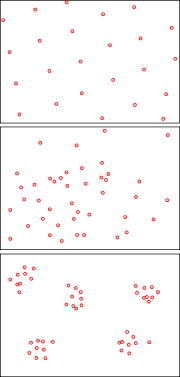.gif)
Range (biology)
Encyclopedia

The term is often qualified:
- sometimes a distinction is made between a species' native range and the places to which it has been introduced by human agency (deliberately or accidentally), as well as where it has been re-introduced following extirpationLocal extinctionLocal extinction, also known as extirpation, is the condition of a species which ceases to exist in the chosen geographic area of study, though it still exists elsewhere...
. - for species which are found in different regions at different times of year, terms such as summer range and winter range are often employed.
- for species where only part of their range is used for breeding activity, the terms breeding range and non-breeding range are not used.
- when discussing mobile animals, the species' natural range is often discussed, as opposed to areas where it occurs as a vagrantVagrancy (biology)Vagrancy is a phenomenon in biology whereby individual animals appear well outside their normal range; individual animals which exhibit vagrancy are known as vagrants. The term accidental is sometimes also used...
. - geographic or temporal qualifiers are often added e.g. British range or pre-1950 range.
There are at least five types of distribution patterns:
- scattered/random (Random placement)
- clustered/grouped (The majority are placed in one area)
- linear (Their placements form a line)
- radial (Placements form a ' x ' shape)
- Regular/ordered (They are not random at all, but follow a set placement. Much like a grid)
See also
- Biological dispersalBiological dispersalBiological dispersal refers to species movement away from an existing population or away from the parent organism. Through simply moving from one habitat patch to another, the dispersal of an individual has consequences not only for individual fitness, but also for population dynamics, population...
- ColonisationColonisation (biology)Colonisation is the process in biology by which a species spreads into new areas, regions, and continents. It is sometimes also referred to as immigration, but colonisation often refers to successful immigration with integration to a community, having resisted initial local extinction.One classic...
- Occupancy-abundance relationshipOccupancy-abundance relationshipIn macroecology, the occupancy-abundance relationship is the relationship between the abundance of species and the size of their ranges within a region. This relationship is perhaps one of the most well-documented relationships in macroecology, and applies both intra- and interspecifically . In...
- Species distributionSpecies distributionSpecies distribution is the manner in which a biological taxon is spatially arranged. Species distribution is not to be confused with dispersal, which is the movement of individuals away from their area of origin or from centers of high population density. A similar concept is the species range. A...

